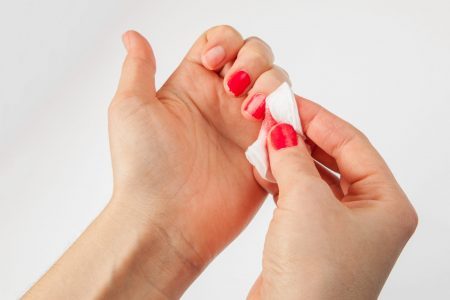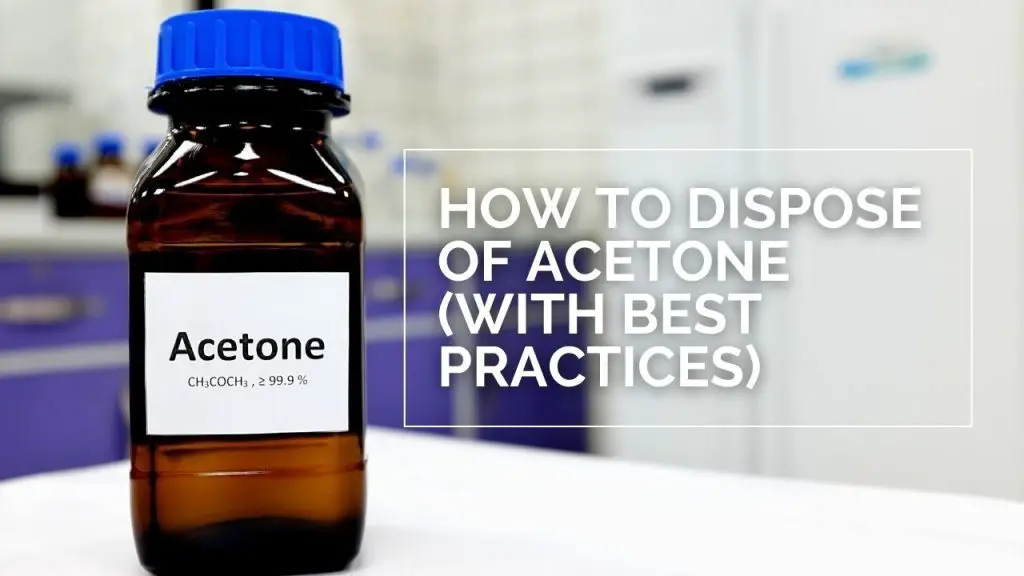Despite being a common standard in many households, Acetone is a rather dangerous chemical. If it is not disposed of correctly, it can cause some pretty severe damage.
Acetone needs to be disposed of properly. Small amounts of contaminated rags or cotton balls can be thrown in the trash, but more significant amounts or acetone containers must be taken to a hazardous waste disposal facility.
On this page, we want to walk through absolutely everything you need to know about Acetone and, perhaps more importantly, how to dispose of it safely.
What is Acetone?
Acetone is a solvent. It is widespread in many products around the home. For example, it is often found in certain wood varnishes and stains.
It is used as a paint stripper. It is even used in some adhesives.
However, most people will be familiar with Acetone through nail-polish remover. That product is just Acetone with a small amount of isopropyl alcohol mixed into it (also dangerous!)
How Dangerous is Acetone?
Whenever you use an acetone-based product, you will have to keep the windows open. In some cases, you may even have to wear a mask.
This is because Acetone is an incredibly harsh chemical. Even small amounts can cause severe breathing problems.
Acetone is also a highly flammable liquid. If a naked flame even gets close to it, it will ignite. In fact, not only will the Acetone light up, but pretty much everything close to the Acetone will too.
As you can probably guess, Acetone is a chemical you must take care of when you dispose of it. If you don’t, your garbage can is at risk of catching alight.
Everywhere that Acetone travels from your home to the landfill is at risk of catching alight. It is just that flammable. Granted, something will rarely ignite the Acetone, but the risk exists.

Once improperly Acetone is disposed of in the ground, it will start leaking into the surrounding soil. This will make the land infertile (Acetone is just one of a few chemicals that can do this).
There is also a good chance that the Acetone will get into the local water supply. This is going to be dangerous for both humans and animals.
Thankfully, disposing of Acetone safely isn’t going to be all that difficult. In the next section, we want to discuss how to dispose of Acetone properly.
How Do You Dispose of Acetone?
How you dispose of the Acetone will depend on how much you have. If you have smaller amounts, you can throw them into your regular garbage. However, you will need to do a small part of the preparation beforehand.
Small Amounts of Acetone
If you are using Acetone as a nail polish remover, then put the cotton balls that you used to apply the nail polish remover into a metal container. The metal container needs to have a lid that can be completely sealed.
You do not want any of that Acetone leaking out. Before you place the metal container into your garbage can, you will want to ensure that you double-bag it. This means that Acetone now has double the amount of protection.
The chances of it leaking out of the metal container are virtually nil. The bag will provide a bit of added protection if it does.
It is essential that you only use metal containers for the Acetone. Because Acetone is a potent chemical, it will ‘eat through’ every other container.
It could probably get through a standard plastic container in a couple of hours. There will be no protection there.
If you use cotton balls to apply the Acetone, you may want to squeeze the cotton balls out for a bit of added protection. You can then have one metal container for the cotton balls and another for the loose Acetone.
Sure, it will be a tiny bit of extra effort, but it will be worth it. After all, the Acetone won’t all be concentrated in a singular place, particularly with something as flammable as cotton balls.
Larger Amounts of Acetone
If you have more significant amounts of Acetone, e.g., paint thinners, etc., you cannot throw it in the regular trash. This may be illegal in many parts of the United States.
More significant amounts of Acetone will always need to be taken to your local hazardous waste disposal facility. These places are scattered throughout the United States, so it shouldn’t be difficult to find somewhere to take your Acetone.
Once you have dropped the Acetone off, the hazardous waste disposal facility will ensure that they dispose of it safely. A lot of the time, they will put the Acetone into large metal containers. It is similar to what you would have been doing with small amounts of Acetone, albeit at a far grander scale.
Empty Acetone Bottles
Empty bottles that contain Acetone should always be taken to a hazardous waste disposal facility. This includes small nail polish remover bottles.
It may seem like a huge hassle, but we promise you this is the safest option. It is going to be a whole lot better for the environment too.
Can You Reuse Acetone?
Acetone can be reused in some situations. For example, some people clean old coins with Acetone. It can be reused if you filter out any dirt and grime inside the Acetone.
This is the only situation in which Acetone can be reused, e.g., you wouldn’t reuse Acetone once you have used it to remove nail polish. It won’t be anywhere near as effective.
Conclusion
Acetone is a hazardous chemical. It would be best if you disposed of it properly. Thankfully, there will almost certainly be a hazardous waste disposal facility close by. Under no circumstances should you ever dispose of more than a small amount in the regular trash.

